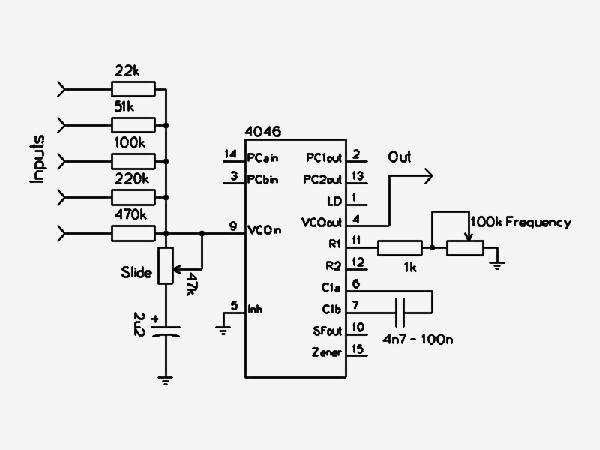Table of Contents
Modular Synth
| DIY Modular Synth aka Samohrajka | |
|---|---|
 |
|
| founder: | harvie |
| depends on: | |
| interested: | |
| software license: | |
| hardware license: | |
~~META: status = suspended &relation firstimage = :project:electribe-blue.jpg ~~
Goals of this project:
- Device should produce danceable-noise (so 8-bit lovers will be able to party all night)
- Device should be as simple as possible (so everyone can resemble it)
- All components should be available all around the world
- All components should be as cheap as possible
CyberTrip
I've ordered small strobe from china, so once it arrives i can tune it on 10Hz and synchronize the noise with it. And i believe this can make audience in small darkened room of hackerspace pass to their inner hyperspace (or to photosensitive epilepsy shock).
Links
- Components
- Discrete Transistors
- Oscillators
- LFO
- http://kennethfinnegan.blogspot.com/2010/01/three-transistor-ring-oscillator.html - Simple MOSFET Ring Osc
- http://www.musicfromouterspace.com/analogsynth/NewAugustRampLFO.html - Ramp/Sawtooth Generator
- (White) Noise Generators
- LFSR PRSB Generators
- Effects
- Simple RC filters
- Wave shapers
- Frequency Modulation
- http://www.instructables.com/id/Lo-fi-Arduino-Guitar-Pedal/ (COOL! - Using Arduino for DSP)
- Synths
- Consumer-ready
- Monotron seems to be cheap and hackable device. monotron_schematic.pdf
- CCC 2010
- http://www.musicfromouterspace.com/ (Home of “WSG - Weird Sound Generator”)
- 555 Synths
- CMOS Synths
- Lunetta
- http://electro-music.com/forum/forum-160.html - Lunettta Forum
- http://www.beavisaudio.com/Projects/CMOS_Synthesizers/ - Various COOL circuits with 40106, 4050, 4041
- http://www.milkcrate.com.au/_other/sea-moss/ - Various circuits with 40106, 4040, 4051
- http://frank.harvard.edu/~paulh/misc/lorenz.htm - Lorenz Chaotic Attractor
- http://hackaday.com/2008/11/17/auduino-software-synth/ - Arduino Granular Synth
- http://www5b.biglobe.ne.jp/~houshu/synth/ - Advanced modular synths
-
-
- Forums
- Analog Controllers
- Potentiometers
- Resistive Ribbons
- Touch/Bend sensors
- Sequencers
- http://www.doctronics.co.uk/4017.htm (4017 CMOS HOWTO)
Tests
RC Filters
I've been trying to build two simple RC filters, here are the results: tIwKH3yEwuU
MIDI controlled synthesizer
Another toy i've made: xEWLfB5klWM
Added another oscillator (wannabe CMOScillator AM modulation) 0qmxovXxpNw
PhotoTransistor Hacks
PhotoTransistor + Remote Controls = Noise Jam QToB4ndZUjA
TouchScreen Synthesizer
First prototype - DIY toy hardly inspired by Korg Kaossilator and Monotron… pwVad9ekE9Y
Simplest Possible CMOS/MOSFET LFO
CMOS oscillators are not capable of generating analogue signal on their output, but the voltage on capacitor of those oscillators is purely analogue. You can see what i've captured using soundcard attached directly to the capacitor of my “CMOScillator”:
 So we can use MOSFET to amplify the voltage on such capacitor and voila - we have analogue LFO!!! (I've chosed MOSFET because CMOS logic is made from MOSFETs and because current can flow in both directions through the MOSFET, so we can use it to drive another “CMOScillator” directly).
So we can use MOSFET to amplify the voltage on such capacitor and voila - we have analogue LFO!!! (I've chosed MOSFET because CMOS logic is made from MOSFETs and because current can flow in both directions through the MOSFET, so we can use it to drive another “CMOScillator” directly).
The shape of the LFO signal can be slightly altered to produce sine, saw-up and saw-down functions by replacing CMOScillators resistor by two resistors (or pots) distinguished using two diodes, so you will be able to have different capacitor charging and discharging time.
Simplest Possible VCO
HardTekno DrumLoop generated usin saw-down LFO (4093 + LED across potentiometer) and simplest possible CMOS VCO. + bit of messing with circuit (eg.: Sonic Devastator Redesign as a bonus). LNHLZY0Hvqk
Schematic of simple VCO using CMOS 4046. Note that i am attaching VCO input directly to positive pin of LFO capacitor (instead of voltage-divider shown in picture), so i can drive the VCO using almost-saw signal from 4093 oscillator. Also note that 4046 VCO (thanks to voltage-driven MOSFET/CMOS technology) does not suck almost any current from the LFO capacitor, so it does not detune it (and i do NOT need any external discrete MOSFET transistor to amplify that signal as originaly wanted to do).

Here you can see some signals from VCO (upper graph) and LFO (lower graph) that i've caputred using soundcard and audacity:
Atari Punk Console
Inspiration
- http://youtube.com/watch?v=iX5CI1jCQeI - PT2399 echo + 4093 quad nand oscillator + TL062 LFO
- http://vimeo.com/10019840 - 40106, 4077, 741, 4069, 3 x osc, ringmod, sync, overdrive, power starve, passive lo-pass filter, 10 x body contact, LM386 amp, 0.25W speaker
KUXRAExVoJI
One of lunetta's (simple DIY modular synths based on CMOS ICs):






